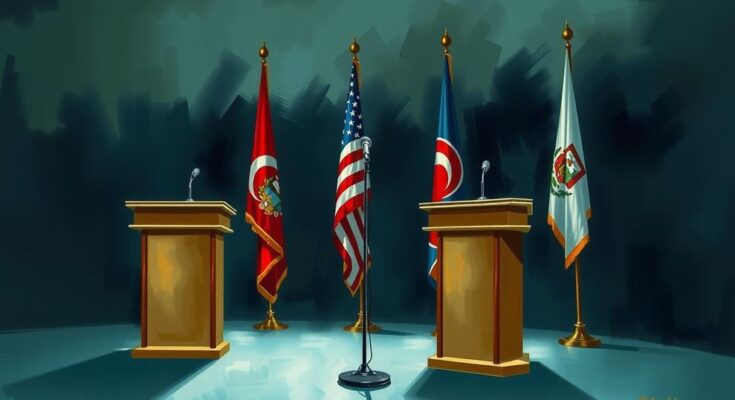In a charged public briefing, Defense Secretary Pete Hegseth took a swing at the media while discussing the U.S. strikes on Iran. The repercussions of these military decisions are still fresh, and many are keen to understand whether these attacks actually made a significant dent in Iran’s nuclear ambitions. President Trump, meanwhile, has confidently proclaimed the success of the strikes while admonishing dissent. Join us as we navigate through the key moments of the press conference and what this all means moving forward.
Intelligence Report Scrutinised Amidst Hegseth’s Comments
Tensions have reached a boiling point as Defence Secretary Pete Hegseth addressed an early-morning press conference, flanked by General Dan Caine. The focus? A leaked intelligence report claiming U.S. strikes against Iran may only have stalled the Iranian nuclear program by mere months. The situation unfolds precariously, with President Donald Trump touting the assaults as “devastating.” Yet, as the dust settles, many are left grappling with the question: what truly is the impact of these military actions? President Trump, not one to shy away from headlines, has been vocal about this narrative, insisting that questioning his military judgement is akin to betraying the nation, further riling up the already charged atmosphere surrounding the conflict.
Hegseth’s Defense Against Media Claims
Hegseth opened the floor, immediately diving into a sharp critique of the media. He lambasted reporters for what he sees as their incessant “scandal-hunting,” insisting that they overlook significant historical achievements like strides in military recruitment and bolstered European defence spending by U.S. allies. The former Fox News host’s words dripped with frustration as he denounced the media’s portrayal of a preliminary intelligence assessment of the strikes, accusing them of sensationalism and irresponsibility. This left many wondering whether the real narrative was being overshadowed by a relentless pursuit of negativity.
Trump’s Social Media Commentary
With the president seemingly glued to the press conference, Trump’s Twitter activity provided a running commentary on the proceedings. “Watch it!” he urged his followers, fanning the flames of interest. He didn’t hold back on expressing disdain for those who reported on the intelligence assessment, suggesting these outlets might soon see the consequences of their so-called fake news. As the administration’s armed involvement in the Middle East hangs in the balance of public perception, Trump’s engagement made it clear that how this narrative unfolds could greatly impact voter attitudes. His fixation sharpens the lens through which viewers might interpret these military operations, setting the stage for potential political fallout.
Critique of Intelligence Assessments
When Hegseth addressed the leaked assessment claiming the strikes only inflicted temporary setbacks on three Iranian nuclear sites, his tone shifted to one of dismissal. He cautioned against placing too much weight on this initial report from the Defence Intelligence Agency, stating it wasn’t fully vetted across the intelligence community. Furthermore, he assured the press that other assessments had painted a more optimistic picture regarding the strikes’ effectiveness in regard to damaging the facilities. This declaration ignited further questions about how the military and intelligence communities assess success in such complex operations.
Caine Recalls Heroic Defence Efforts
General Dan Caine, who accompanied Hegseth, provided a vivid recount of Iranian missile strikes targeting a U.S. base in Qatar. Strikingly detailed, his account seemed aimed at refocusing the narrative away from political debates and onto the bravery of U.S. servicemen. Caine recounted a significant engagement, noting that around 44 American military personnel were present and engaged during what he referred to as the largest single Patriot missile defence action in U.S. history, underscoring the heroism on the ground amid escalating tensions. This narrative pivot aims to cultivate respect while grounding the public discourse in valor.
Concerns Over Recovery and Influence
In a pointed remark, Hegseth condemned what he viewed as irresponsible reporting stemming from initial intelligence leaks, labelling them as biased. He signaled a stronger intent to control the narrative by steering the audience’s attention to the real action, rather than speculation. This rhetoric extended to suggestions of physically investigating the compromised Iranian sites if one wishes to hear the truth. While the Pentagon’s briefing intended to inform about military tactics, concrete details about the actual damage remain notably sparse. There are still lingering uncertainties over how quick Iran might recover or if they managed to relocate significant nuclear materials prior to the strikes, as speculations abound.
What was the purpose of Hegseth’s press briefing?
The news conference addressed the impact of U.S. strikes on Iranian nuclear facilities as well as media coverage surrounding it.
What did Hegseth say about media reporting?
Hegseth criticized the media for allegedly ignoring positive news and focusing on scandalous reports regarding the military actions.
How did President Trump react to the news conference?
Trump’s social media posts hinted at his monitoring of media coverage and the Pentagon briefing, suggesting potential repercussions for reporters.
What did Hegseth say regarding the leaked intelligence assessment?
Hegseth downplayed the importance of the preliminary intelligence report, suggesting more thorough evaluations might show better outcomes from the strikes.
What did General Caine discuss during the conference?
General Caine described the American military response to an Iranian missile attack, emphasizing heroism and effectiveness in the face of danger.




